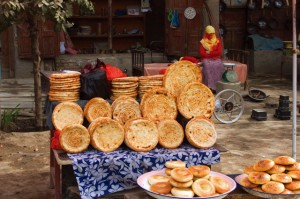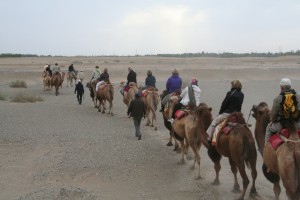When you first heard of the Silk Road, you might have had romantic ideas of a smooth road made out of silk. In reality, the Silk Road is not even a road at all but an ancient network of trading routes that linked China all the way to the Mediterranean Sea. Also, the road is not paved in silk and was far from a smooth journey in historic times. Judy Bonavia describes it well below:
“The early trade in silk was carried on against incredible odds by great caravans of merchants and animals traveling over some of the most inhospitable territory on Earth, including searing, waterless deserts and snowbound mountain passes. Beginning at the magnificent ancient Chinese city of Chang’an (Xi’an), the route took traders westward along the Hexi Corridor to the giant barrier of the Great Wall, then either orth or south of the Taklamakan Desert to Kashgar before continuing on to India and Iran, or farther to the great cities of Constantinople, Damascus and Baghdad. For today’s traveler, it is not only the weight of history that makes the Silk Road intriguing, but the incredible diversity of scenery and ethnic people along the way.” –The Silk Road: Xi’an to Kashgar
The Silk Road earned its title because silk made up a large proportion of trade along this route. Originating in China, silk-making was China’s well-guarded secret for almost 2,000 years. Silk was so valuable to people that prices were calculated in lengths of silk, just like they had been calculated in pounds of gold. It even became a currency used in trade with foreign countries.
Silk was not the only good traded on the Silk Road-people traded bronze, bamboo products, teas, medicine, and porcelain. There were many available routes to travel; ome were shorter and more dangerous, while others were longer and safer. Most of the things traded along the Silk Road were luxury items because the profit, to some, was worth the risk.

People exchanged religion, culture, philosophy, and art along the Silk Road. The route connected merchants, monks, and nomads from around the world and was an ancient highway for globalization. Innovative ideas that were traded along the route, like grape winemaking and paper money, are still in use today. By allowing people to make their first contact with distant civilizations, the Silk Road helped lay the foundations for the modern world.
Today, these ancient routes aren’t used to trade goods and ideas with other countries. Instead, the Silk Road is traveled by people who want to see the land and learn about the history and culture of the region. Most of the Silk Road is located in Xianjiang province in northwest China. Xianjiang is home to 47 ethnic minorities, including the Uygur, the major ethnic group living here. Uygur are the second largest Muslim ethnic group in China. They have their own Islamic culture and Turkic language, which uses a modified form of the Arabic alphabet.

China’s northwest region is home to the beginning of the old, dangerous route, earning the nickname, “Wild West of China”. Today the region is safe and more accessible. While in this part of the country you feel like you are in Central Asia, not typical China. The people, clothes, culture, and cuisine are influenced from the ancient trade routes. Those who visit are fascinated by the diverse culture, people, and landscape.
If you are interesting learning about the Silk Road, we recommend reading, The Silk Road:from Xi’an to Kashgar, by Judy Bonavia. For a hands on experience, AsiaTravel offers a trip, Along the Silk Road, departing in October.
